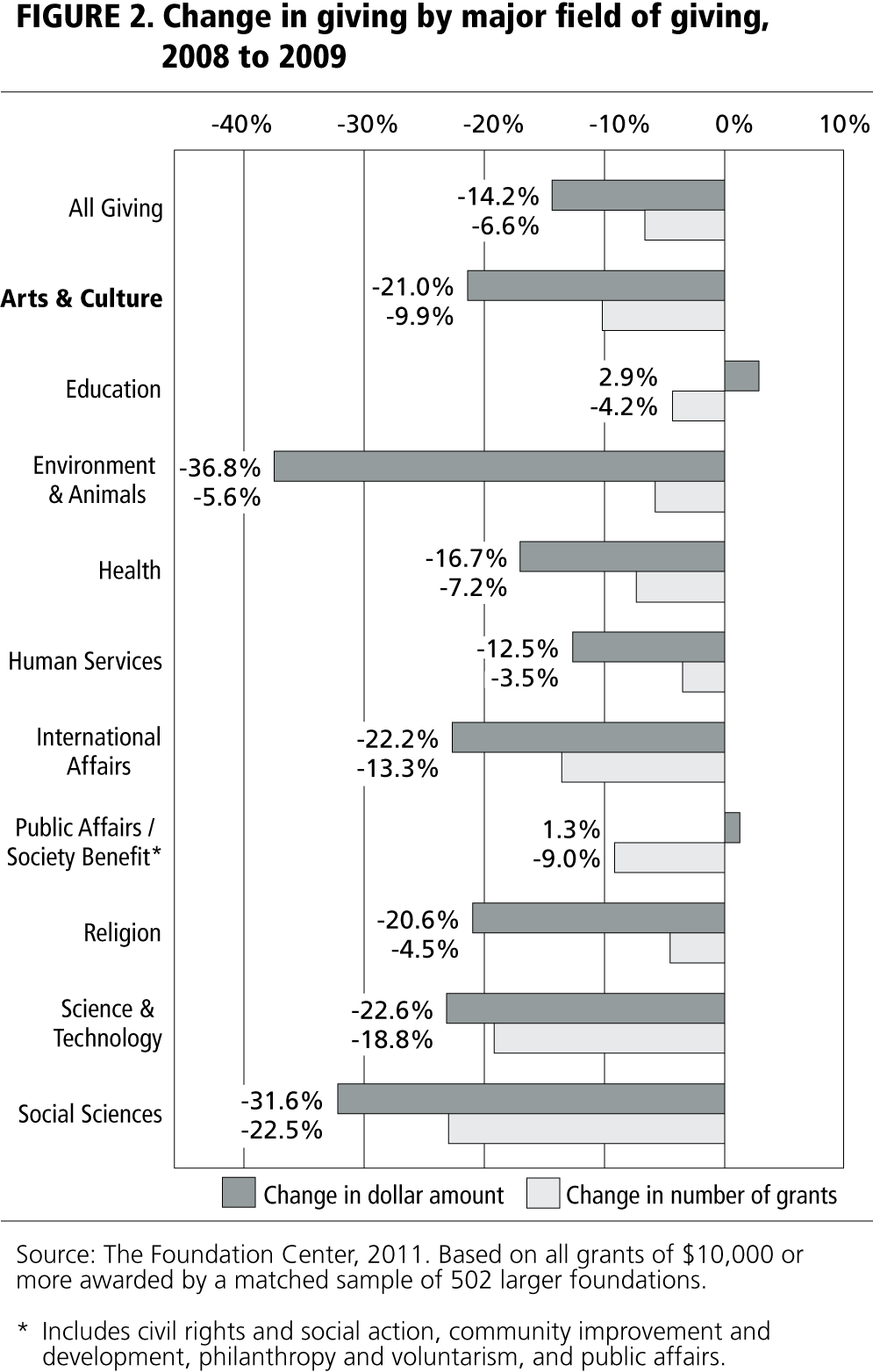Foundation Grants to Arts and Culture, 2009
A One-year Snapshot
Download:
![]() Arts Funding Snapshot: GIA's Annual Research on Support for Arts and Culture (5Mb)
Arts Funding Snapshot: GIA's Annual Research on Support for Arts and Culture (5Mb)
Highlights
The Foundation Center offers these key findings from GIA's tenth snapshot of foundation giving to arts and culture. The definition of arts and culture used for this snapshot is based on the National Taxonomy of Exempt Entities and encompasses funding for the performing arts, museums, visual arts, multidisciplinary arts, media and communications, humanities, and historical preservation. Most importantly, the findings tell us about the changes in foundation giving for the arts between 2008 and 2009 by a matched set of 502 funders1 and the distribution of 2009 arts and culture giving by a larger sample of 1,384 foundations. They are based on all arts grants of $10,000 or more reported to the Foundation Center by these sets of the largest US foundations, hereafter referred to as “the sample.”2 The Center has conducted annual examinations of the giving patterns of the nation's largest foundations for more than three decades.
Foundation funding for arts and culture decreased faster than overall giving in 2009. Arts funding declined 21 percent between 2008 and 2009, compared to a 14.2 percent reduction in overall giving by these foundations. Of the 10 major funding areas, only education and public affairs/society benefit posted growth in giving. Among the eight fields showing declines, the environment and animals, social sciences, science and technology, and international affairs posted larger decreases than the arts.
Arts funding represented a smaller share of total dollars included in the full 2009 grants sample. Among the full set of 1,384 foundations included in the grants sample for 2009, arts giving totaled $2.3 billion, or 10.5 percent
of overall grant dollars. This share was down from 12.5 percent in 2008 and the lowest share recorded over the past decade.
The size of the median arts grant remained unchanged. The median arts and culture grant size – $25,000 – did not change from 2008 to 2009, and the real value of the median grant remained basically unchanged due to marginal deflation. This value was also equal to the median amount for all foundation grants in the latest year and has not changed since 1993.
Large grants slipped to less than three-fifths of arts grant dollars. Large arts grants of $500,000 and more captured just over 56 percent of total grant dollars for the arts in the 2009 sample, down from roughly 64 percent in 2008. Much of this decline resulted from a reduction in the number and size of capital grants.
Relative to other fields, a larger share of arts grant dollars provided operating support. In 2009, general operating support accounted for 35 percent of arts and culture grant dollars, by far the largest share compared to other major funding areas. This share was up from 27 percent in 2008. By comparison, just 13 percent of arts grant dollars in 1989 provided operating support.
Top arts funders accounted for a smaller share of overall giving. The top 25 arts funders by giving amount provided 35.3 percent of total foundation arts dollars in 2009, down from almost 40 percent in 2008. The share of arts giving accounted for by the top funders remains well below the more than 50 percent shares recorded in the early 1980s.
Please note
It is important to keep in mind that the foundation grantmaking examined here represents only one source of arts financing. It does not examine arts support from earned income, governments, individual donors, or the business community. This analysis also looks only at foundation arts support for nonprofit organizations, and not for individual artists, commercial arts enterprises, or informal and unincorporated activities. In addition, the analysis of changes in giving between 2008 and 2009 is based on a matched subset of 502 funders, while statistics on the distribution of funding and actual dollar amounts and numbers of grants are based on the full set of 1,384 grantmakers included in the Foundation Center's 2009 grants sample (See note 1).
Specific Findings
Overall foundation dollars for the arts. The 1,384 larger foundations included in the Foundation Center's 2009 sample awarded 20,685 arts and culture grants totaling $2.3 billion, or 10.5 percent of overall grant dollars (figure 1). Arts giving declined 21 percent between 2008 and 2009, surpassing the 14.2 percent decrease in grant dollars overall. Among the nine other major subject areas tracked by the Center, only two areas — education and public affairs/society benefit — grew during this period. Among the seven remaining areas, all registered double-digit declines in grant dollars. The environment and animals, social sciences, science and technology, and international affairs experienced more rapid decreases in grant dollars than the arts (figure 2).
The impact of exceptionally large grants. Every year and in all funding areas, a few very large grants can skew overall totals, creating distortions in long-term grantmaking trends. In 2009, 18 arts and culture grants totaled at least $10 million, and instances where these grants had a notable impact on grantmaking patterns are identified in the following analyses. Yet despite the potential fluctuations caused by these exceptional grants, Foundation Center data in all fields have always included them, providing consistency over time. (In addition, the Foundation Center provides statistics based on share of number of grants, which are not skewed by exceptionally large grants.)
Corporate foundations represent an important source of support for arts and culture. While corporate foundations account for less than 4 percent of US private and community foundations, the larger corporate foundations included in the 2009 grants sample provided 14.4 percent of grant dollars for the arts (figure 3). Actual grant dollars totaled $337.6 million. By number, corporate foundations allocated 4,574 grants, or 22 percent of the overall number of arts grants in 2009.
Grants by arts subfield
Funding for museums accounted for over one-third (36.7 percent) of all foundation arts dollars in 2009 (figure 4), surpassing the share reported for the performing arts (30.8 percent). From the start of the 1980s until 1997, the performing arts consistently received more foundation support than museums. However, museums have surpassed the performing arts by share in several recent years (1998, 1999, 2001, 2004, 2005, and 2008). More study would be needed to adequately understand the underlying reasons for the shifts in share between these two fields of activity, for example, the entry onto the scene of new and large arts funders, extraordinarily large grants, the contribution of valuable art collections, and new capital projects at museums.
Giving to museums. Grant dollars allocated to museums declined by less than 1 percent between 2008 and 2009. However, the number of grants they received fell by just over 12 percent. The 1,384 foundations included in the full sample awarded 4,373 grants totaling $865.1 million for museums in 2009. Among museum types, more than half of funding (54.6 percent) supported art museums. The largest arts grant in the latest sample was a $106 million general support grant from the American Art Foundation to the Whitney Museum of American Art.
Giving to performing arts. In 2009, performing arts grant dollars decreased by about 19 percent, although the number of grants decreased by less (7 percent). A total of 8,628 grants were awarded for the performing arts by the overall set of 1,384 foundations — close to double the number reported for museums — and their value surpassed $718 million. In general, the average performing arts grant tends to be smaller in size than the average museum grant. The largest share of giving to the performing arts supported the performing arts generally (including performing arts centers and education), followed by music (including symphony orchestras and opera), theater, and dance.
Giving to media and communications. Support for media and communications3 represented 11.2 percent of arts funding in 2009, down from 12.9 percent in 2008. Grant dollars fell nearly 40 percent in the latest year.
Giving to multidisciplinary arts. The share of arts giving for multidisciplinary arts declined marginally to 7.7 percent in 2009. However, actual dollars awarded for multidisciplinary arts were down 33 percent from 2008. Multidisciplinary arts includes support for multidisciplinary centers, ethnic/folk arts, arts councils, and arts education. Arts education represented about 5 percent of overall arts grant dollars in 2009 and 8 percent of grants. These shares were nearly unchanged from 2008.4
Giving to historic preservation. Support for historic preservation slipped 14 percent between 2008 and 2009, compared to a 21 percent overall rate of decline in arts funding. Within the full set of grantmakers, historic preservation benefited from $128.3 million in 2009.
Giving to the humanities. Funding for the humanities5 decreased to 3 percent of arts grant dollars in 2009, down from 5 percent in 2008. Support for the field dropped nearly 74 percent during this period.6 The decrease was due in part to Andrew W. Mellon Foundation awarding several exceptionally large multi-year grants in 2008 for the humanities.
Giving to the visual arts. Grant dollars for the visual arts and architecture declined 30.9 percent between 2008 and 2009, and the number of grants for the field decreased 19.1 percent. Within the full set of grantmakers, visual arts and architecture benefited from $74.9 million in 2009, down from $101 million in 2008. Moreover, this total represented less than half of the record $167.6 million in support for the visual arts tracked in the 2006 sample.
Grants by types of support
An important caveat to a report on the allocation of foundation dollars by specific types of support is that, for roughly 21 percent of arts grant dollars in the 2009 Foundation Center sample, the type of support could not be identified. This means that modest differences in percentages — that is, variations under 10 percent — may not be reliable. (The grant records available to the Foundation Center often lack the information necessary to identify the type of support. For example, it is often the case that the only source of data for this sample on foundations' grants is the 990-PF tax return, and this tends to be less complete than other forms of grant reporting.)
The arts compared to other foundation fields of giving. The three largest categories of support tracked by the Foundation Center are program support, general operating support, and capital support. Of these, special programs and projects typically receive the largest share of arts and culture grant dollars and grants. In fact, the same is true in most of the major fields, such as health and education, where program support consistently accounts for the largest share of funding.
General operating support accounted for the second largest share of arts grant dollars in 2009 (35 percent). The shares of grant dollars and number of grants allocated for this type of support in 2009 were higher for arts and culture (35 percent and 35.4 percent, respectively) than for all other fields. Moreover, the portion of grant dollars allocated to this type of support has risen markedly over the past two decades; operating support represented only 13 percent of arts funding in 1989.
Capital support captured just over 20 percent of the share of arts grant dollars in 2009, down markedly from roughly 33 percent in 2008. Nonetheless, the share of grant dollars allocated for this type of support was higher for arts and culture than for all but one field (science and technology). Grants for capital support are larger on average than awards for program and general operating support, and exceptionally large capital grants can have a pronounced effect on the distribution of funding by type of support. In fact, arts dollars allocated to capital support have fluctuated more than arts dollars to the other two primary categories of support: in 1986 the share allocated to capital was about 44 percent; in 1993 it was about 30 percent; and in 1999 it was about 41 percent. (In general, the share of capital support is highest in periods of strong foundation asset growth.)
Arts grants by specific types of support. Table 1 provides a breakdown of more specific types of support within the larger support categories and lists both the specific dollar value and number of grants made in each type. As with all data in the Snapshot, it is important to keep in mind that this table includes only grants of $10,000 or more awarded to organizations by a sample of 1,384 larger foundations. It is also important to note that just over 21 percent of the arts grant dollars in this sample were not specified for a type of support.
Grants by grant size
Median grant size. The median or “typical” grant amount7 for arts and culture in 2009 was $25,000, which matched the median amount for all foundation grants ($25,000). This amount has remained unchanged since 1993. If this amount were adjusted for inflation, however, it would have lost value in real dollars. More study would be required to determine whether the unchanged median means that foundation arts grants simply are not keeping pace with inflation, or whether, in combination with the increased number of grants, it means that foundations are choosing to distribute funds more broadly to a larger number of recipients.
Small and mid sized grants. Two-thirds (66 percent) of all arts grants in the 2009 sample were for amounts between $10,000 and $49,999 (table 2), almost identical to the 2008 share. The share of mid-sized arts grants ($50,000 to $499,999) also remained fairly consistent at just over 30 percent.
Large grants. The share of larger arts grants ($500,000 and over) decreased over the same period: larger grants represented 3.5 percent of the total number of arts grants in 2009, compared to 4.3 percent in 2008. Their share of total grant dollars fell from 63.9 percent to 56.1 percent. Overall, foundations in the sample made 85 arts grants of at least $2.5 million in 2009, down from 146 in 2008 and 110 in 2007.
In addition to the $106 million grant from the American Art Foundation to the Whitney Museum of American Art (noted earlier), examples of other especially large grants in the 2009 sample included the Donald W. Reynolds Foundation's $38 million award to The Mount Vernon Ladies Association to establish a traveling exhibition Discovering the Real George Washington and to Fred W. Smith National Library for the Study of George Washington; Annenberg Foundation's $18.5 million to Los Angeles County Museum of Art to acquire Vernon Collection and Transformation as part of the LACMA Campaign; and Bill & Melinda Gates Foundation's $10 million grant to the Smithsonian Institution for a capital campaign to support the National Museum of African American History and Culture.
The twenty-five largest arts funders. The top twenty-five arts funders by giving amount provided 35.3 percent of the total arts dollars in the Foundation Center's 2009 sample (table 3), down from nearly 40 percent in 2008. Overall, the share of giving accounted for by the top twenty-five arts funders has fluctuated between 33 and 39 percent since the end of the 1990s. In the early 1980s the top twenty-five arts funders accounted for more than half of the grant dollars in the sample. This suggests that the base of large arts funders has widened since that time, making arts funding less concentrated among a small number of foundations.
Top foundations by share of arts giving out of overall giving. Of the foundations that committed large percentages of their grant dollars to arts and culture, many are the smaller foundations in the sample (table 4). Among the top 100 foundations ranked by share of arts giving out of total giving, over half of foundations (57) gave less than $5 million in total arts grant dollars in 2009. This share would be greater if grants of less than $10,000 were included, because some arts funders will either primarily or exclusively award arts grants of less than $10,000 each.
Giving for international cultural exchange
Foundation grant dollars targeting international cultural exchange fell 60.7 percent between 2008 and 2009. The Foundation Center's full 2009 grants set included 145 grants related to international cultural exchange totaling $13.5 million. Among the largest of these awards was a $1.5 million grant from the Houston Endowment to the Asia Society Texas for a challenge grant toward construction of Asia House, a facility to present Asia-centric programs in the fields of art, culture, business, policy, and education. By comparison, the largest grant reported in 2008 was a $7.8 million award from the Bill & Melinda Gates Foundation to the Asia Society to expand the International Studies Schools Network.
Notes
- Over time, the sample size has changed, which could also distort year-to-year fluctuations in grant dollars and grants targeting specific activities or populations. To account for these potential distortions year-to-year, the Foundation Center has analyzed changes in giving based on a matched set of funders.
- Source of the data. The original research upon which this report is based was conducted by the Foundation Center. Specifically, the source for data was the Foundation Center's Foundation Giving Trends: Update on Funding Priorities (2011) report and the grants sample database. The data for “circa 2009” include all grants of $10,000 or more awarded by 1,384 of the largest US foundations and reported to the Foundation Center between June 2009 and July 2010. Three-fifths of grant dollars represent 2009 grant authorizations or payments, with the balance reflecting 2008 authorizations or payments. (The incorporation of “older” data reflects delays in the availability of timely grants information.) The grants sample typically represents about half of total grant dollars awarded annually by the more than 76,000 active US independent, corporate, and community foundations that the Foundation Center tracks. (The sample also captures roughly half of all foundation giving for arts and culture.) For community foundations, only discretionary and donor-advised grants were included. Grants to individuals were not included.
- Includes support for the production and dissemination of one or more media forms including film/video, television, radio, and print publishing, and support for journalism and communications centers.
- For a detailed analysis of foundation funding for arts education, see L. Renz and J. Atienza, Foundation Funding for Arts Education (New York: Foundation Center, 2005).
- Includes support for archeology, art history, modern and classical languages, philosophy, ethics, theology, and comparative religion.
- For a detailed analysis of foundation humanities support, see L. Renz and S. Lawrence, Foundation Funding for the Humanities, New York: Foundation Center, 2004.
- The median — meaning that half of the grants are above and half are below the amount — is generally acknowledged to be a more representative measure of the typical grant than the mean or “average,” because the median is not influenced by extreme high or low amounts.








